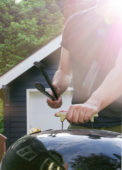Skill Builder: How to Make Raised Panel Cabinet Doors, Part I – The Tools
![credit: David [manmadediy.com] Raised Panel Doors](https://s3.amazonaws.com/manmadediy-uploads-production/photos/24528/RPD%20LOGO_large.jpg?1421714461) One of the hallmarks of woodworking that just about everyone has come into contact with is the raised panel cabinet door. The solid construction, clean design, and intricate jointery are sometimes taken for granted; but for years I thought it was a skill just a bit out of my reach as a home woodworker. Turns out a few anchor tools and some awesome bits are all it takes to make doors worth bragging about.
One of the hallmarks of woodworking that just about everyone has come into contact with is the raised panel cabinet door. The solid construction, clean design, and intricate jointery are sometimes taken for granted; but for years I thought it was a skill just a bit out of my reach as a home woodworker. Turns out a few anchor tools and some awesome bits are all it takes to make doors worth bragging about.
- To get started, you will need a stationary table and a router powerful enough to spin the hefty bits. I opted for the following pieces:
![credit: David [manmadediy.com] Router Table With Fence](https://s3.amazonaws.com/manmadediy-uploads-production/photos/24529/IMG_7899_large.jpg?1421714550)
- MLCS Router Table with Fence – $189 This table is strong, sturdy, and I went with the Aluminum plate for longevity. I didn’t get legs, because I decided to sink it into my countertop for a very stable cutting area. I picked it up on sale during black Friday for about $130 but even at full price it’s hard to beat.
![credit: David [manmadediy.com] Craftsman Router With Plate](https://s3.amazonaws.com/manmadediy-uploads-production/photos/24530/IMG_7895_large.jpg?1421714695)
- Craftsman 1¾ HP router Kit – $90 The router is the workhorse of the table, and needs to spin a large bit with some power behind it. A ½” shank accepts the large 3.5” wide panel bit and has variable speed which is required when working with such hefty bits. I also chose this model because it allows for an above table lift via a small included hex so router setup is a bit easier. While it’s not as smooth as the more expensive dedicated router lifts, it’s a nice feature I use often when fine tuning.
![credit: David [manmadediy.com] MLCS Raised Panel Router Bits](https://s3.amazonaws.com/manmadediy-uploads-production/photos/24531/IMG_7891_large.jpg?1421714845)
- MLCS 6 Piece Panel Cutting Bit Set – $120 This is another item I bought on sale during black Friday, and it came with a nice design software for calculating door dimensions. The 6 piece set includes every bit needed to construct raised panel doors and also came with a few set-up blocks which improves accuracy and speed during adjustments.
- MLCS Router Table with Fence – $189 This table is strong, sturdy, and I went with the Aluminum plate for longevity. I didn’t get legs, because I decided to sink it into my countertop for a very stable cutting area. I picked it up on sale during black Friday for about $130 but even at full price it’s hard to beat.
Whatever set-up you choose to get or already have, here are a few items to keep in mind:
- A 3.5” bit moves with some force and can really eat into a piece of wood fast. When working with such large bits, utilize a few feather boards to make it all a bit safer and to keep from ruining premium wood. Also, make a few shallower cuts instead of a single pass, it’s less work on the tools and the cut comes out cleaner.
- A solid fence is one of the most important parts of a stable router setup. Spend the extra for a tall, wide, and highly adjustable fence to make sure there’s enough support to hold it all steady.
- All bits are designed to spin at different RPMs. This is especially important when working with large diameter bits which need a slower speed. Spinning such a big bit at high speeds is dangerous and can result in a low quality cut. Here’s a rough estimation, but follow the manufacturer’s specs for best results:
Router Bit Diameter – Max Speed
Up to 1″ – 22,000 – 24,000 rpm
1″ to 2″ – 18,000 – 22,000 rpm
2″ to 2-1/2″ – 12,000 – 16,000 rpm
2-1/2″ to 3-1/2″ – 8,000 – 12,000 rpm
4. While Oak and Maple are good for some projects, but they’re a beast to work. Poplar sands down silky smooth, and MDF is easy to work and looks great when painted. Also, when staining be sure to have the right wood filler on hand for the best results.
5. Lastly, this process kicks up a ton of dust and chips. I have a dust collector system hooked up to the fence, but at least plan on running a shop vac to keep the wood from ending up everywhere.![credit: David [manmadediy.com] Featherboards and A Big Bit](https://s3.amazonaws.com/manmadediy-uploads-production/photos/24532/IMG_1001_large.jpg?1421715038)
Next week, we’ll talk about setting up and making sawdust. Mastering a few basic steps add speed and accuracy to the process with great results.









